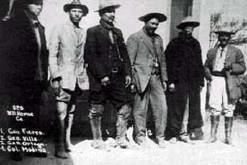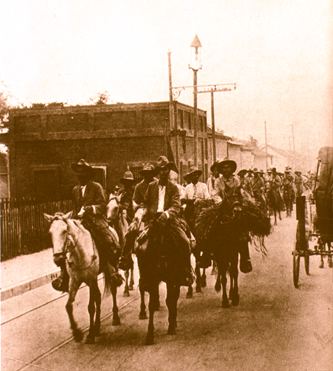1,000 (estimate) 6,000-7,000 (estimate) Result Decisive rebel victory | Date 23 June 1914 | |
 | ||
over 20,000 (estimate) 7,000-15,000 (most likely 12,000) Similar Mexican Revolution, Battle of Celaya, Battle of Ciudad Juárez, Ten Tragic Days, Pancho Villa Expedition | ||
The Battle of Zacatecas, also known as the Toma de Zacatecas (Taking of Zacatecas), was the bloodiest battle in the campaign to overthrow Mexican President Victoriano Huerta. On June 23, 1914, Pancho Villa's División del Norte (Division of the North) decisively defeated the federal troops of General Luis Medina Barrón defending the town of Zacatecas. The great victory demoralized Huerta's supporters, leading to his resignation on July 15.
Contents
Background
Zacatecas, a silver mining town of 30,000, possessed a strategic military asset, a railroad junction that had to be captured in order to advance from the north on the capital, Mexico City. Realizing this, Huerta sent one of his better officers, General Medina Barrón, with reinforcements for the federal troops already defending the town. Estimates of the size of his total force range from 7,000 to 15,000, but it is likely he had 12,000 men.

By 1914 the federal army under Huerta had been greatly increased in size from that of Porfirio Diaz and Francisco Madero. However the rank and file conscripts, often randomly press-ganged, were poorly motivated and prone to desertion. By contrast Villa's División del Norte was comparatively well organized, employed trained federal defectors in key roles, and included effective artillery and mounted units.

Venustiano Carranza, the leader of the rebellion, was jealous of Villa's popularity and did not want to give Villa a chance to precede him into Mexico City, so he ordered him to attack Saltillo next after his hard-fought victory at Torreón. Carranza chose General Panfilo Natera instead for the assault on Zacatecas. Medina Barrón easily repulsed his attack. Without authorization, Villa decided to try his luck with his División del Norte of over 20,000 men.
The battle
Zacatecas is ringed by high hills. Medina Barrón placed many of his best troops on two of them, La Bufa and El Grillo, with artillery in support. Smaller hills, such as Loreto and el Sierpe, were also fortified.
Villa let General Felipe Ángeles, a professional soldier and artillery specialist, plan the attack. This process took two days. It was decided to take advantage of the greater numbers and superior artillery of the rebel forces and storm the town from all sides, with the artillery concentrating on La Bufa and El Grillo. The bombardment started at 10 a.m., June 23, 1914. Villa later reported that he and General Angeles narrowly escaped when a shell in a nearby artillery piece exploded killing or wounding all the gun crew.
El Grillo was taken around 1 p.m. Resistance on La Bufa was stronger, in part because Medina Barrón was there, but his soldiers became disheartened by the fall of El Grillo, and La Bufa suffered the same fate late in the afternoon.
General Medina Barrón and his men retreated into the town. With the loss of the northern heights Zacatecas itself was exposed on all sides to artillery and rifle fire. Panic set in, as the defenders expected that Villa's men would show no mercy. The British consul reported that the morale of troops who had fought bravely until this point, suddenly collapsed and the streets became chaotic. Confusion was increased by the explosion of a mine which destroyed most of an entire block in the central city and caused many civilian casualties. The Federal commander ordered a retreat to the neighboring town of Guadalupe, on the road to the city of Aguascalientes, from which reinforcements were expected. However, they found 7,000 fresh enemy troops blocking their way. The federals were slaughtered.
Aftermath
Federal officers taken prisoner were executed, as were Colorado irregulars (supporters of Pascual Orozco, regarded as traitors by Villa).In one incident shortly after the fall of Zacatecas, involving about 500 prisoners, all federal captives of the rank of corporal and above were lined up and shot.
In total, an estimated 6,000-7,000 defenders were killed, many of the rest were wounded, and only Medina Barrón and a few hundred men reached the safety of Aguascalientes. About 700 of Villa's men were killed and 1500 wounded. Civilian casualties are unknown.
Discord between Villa and Carranza continued, with the latter refusing to supply coal for the Division of the North's railroad trains. Villas forces were accordingly unable to move south from Zacatecas and the Division of the North West, commanded by Alvaro Obregon led the advance on Mexico City.
The defeat at Zacatecas marked the end of the old Mexican Federal Army as an effective institution. Huerta fled into exile on 15 July 1914. The remaining Federal commanders ordered the disbandment of the regular army and the rurales (mounted police) in August, following abortive efforts to negotiate a merger with revolutionary factions.
